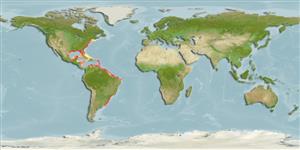>
Eupercaria/misc (Various families in series Eupercaria) >
Sciaenidae (Drums or croakers)
Etymology: Micropogonias: Greek, mikros = small + greek, pogon = beard (Ref. 45335).
More on author: Linnaeus.
Environment: milieu / climate zone / depth range / distribution range
นิเวศวิทยา
เกี่ยวกับทะเล,น้ำเค็ม; กร่อย สัตว์น้ำหน้าดิน; ระดับความลึก ? - 100 m. Subtropical; 43°N - 37°S
Western Atlantic: Massachusetts, USA (excluding Florida) and northern Gulf of Mexico to northern Mexico. Possibly from southern Brazil to Argentina. Uncertain in southern Gulf of Mexico, Lesser Antilles and southern Caribbean (Ref. 26938).
Length at first maturity / ขนาด / น้ำหนัก / Age
Maturity: Lm ?, range 18 - ? cm
Max length : 55.0 cm TL เพศผู้/กระเทย; (Ref. 40637); common length : 30.0 cm TL เพศผู้/กระเทย; (Ref. 3702); น้ำหนักสูงสุดที่มีการรายงาน: 2.6 kg (Ref. 40637); อายุสูงสุดที่ได้รายงาน: 5 ปี (Ref. 12193)
Adults occur usually over mud and sandy mud bottoms in coastal waters and in estuaries where the nursery and feeding grounds are located. They feed mainly on worms, crustaceans and fishes. An excellent foodfish. Sold fresh and frozen; eaten fried, broiled, microwaved and baked (Ref. 9988).
Life cycle and mating behavior
วัยเจริญพันธุ์ | การสืบพันธุ์ | การวางไข่ | เซลสืบพันธ์ของเพศเมีย(ไข่) | ความดกของไข่ | ตัวอ่อน
Robins, C.R. and G.C. Ray, 1986. A field guide to Atlantic coast fishes of North America. Houghton Mifflin Company, Boston, U.S.A. 354 p. (Ref. 7251)
IUCN Red List Status (Ref. 130435)
Threat to humans
Harmless
Human uses
การประมง: การค้า; การเพาะเลี้ยงสัตว์น้ำ: การทดลอง; การตกปลาเป็นกีฬา: ใช่
เครื่องมือ
Special reports
Download XML
แหล่งที่มาจากอินเตอร์เน็ต
Estimates based on models
Preferred temperature (Ref.
123201): 14.2 - 27.7, mean 24.1 °C (based on 540 cells).
Phylogenetic diversity index (Ref.
82804): PD
50 = 0.5156 [Uniqueness, from 0.5 = low to 2.0 = high].
Bayesian length-weight: a=0.00851 (0.00774 - 0.00936), b=3.09 (3.06 - 3.12), in cm total length, based on LWR estimates for this species (Ref.
93245).
ระดับชั้นอาหาร (Ref.
69278): 4.0 ±0.50 se; based on food items.
ความสามารถในการกลับคืนสู่ปกติ (Ref.
120179): ขนาดกลาง, เวลาต่ำสุดที่จะทำให้ประชากรเพิ่มขึ้นเป็น 2 เท่าใช้เวลา 1.4 - 4.4 ปี (K=0.2-0.27; tm=1-2; tmax=5).
Fishing Vulnerability (Ref.
59153): Low to moderate vulnerability (34 of 100).
Climate Vulnerability (Ref.
125649): High to very high vulnerability (66 of 100).
Nutrients (Ref.
124155): Calcium = 74.3 [40.8, 145.2] mg/100g; Iron = 1.07 [0.56, 1.87] mg/100g; Protein = 20.1 [18.4, 21.7] %; Omega3 = 0.303 [0.149, 0.596] g/100g; Selenium = 26.2 [13.9, 50.6] μg/100g; VitaminA = 16.4 [5.7, 55.5] μg/100g; Zinc = 0.688 [0.492, 1.006] mg/100g (wet weight);
